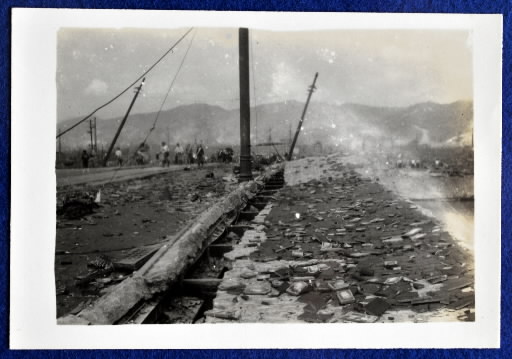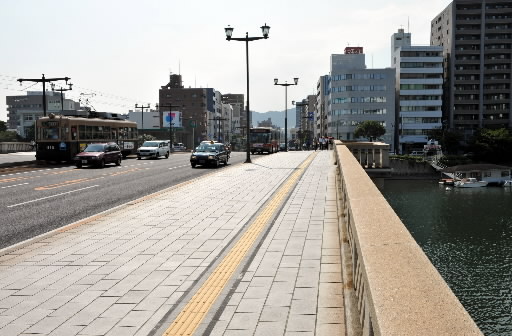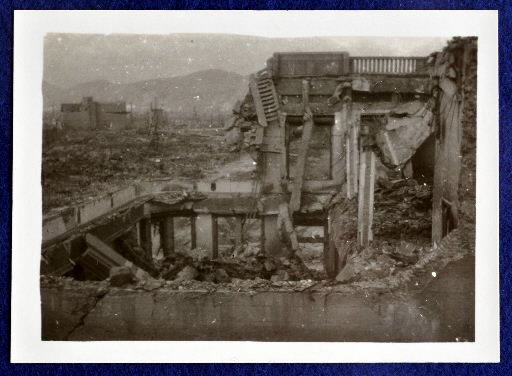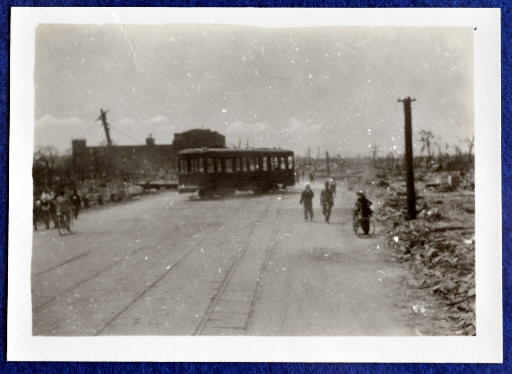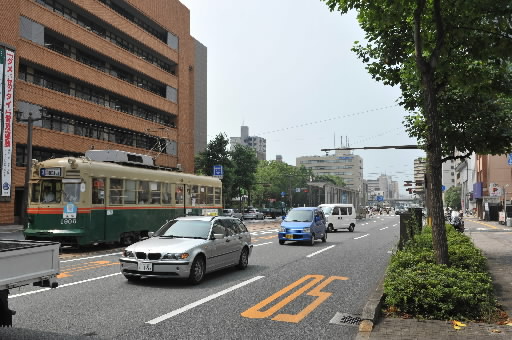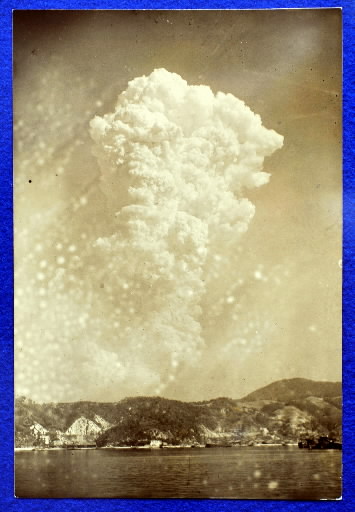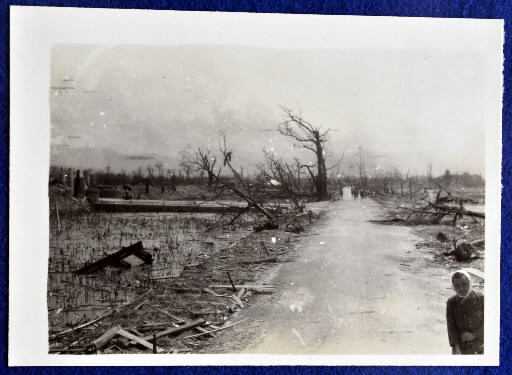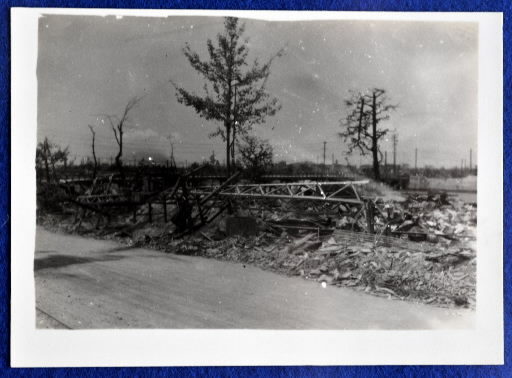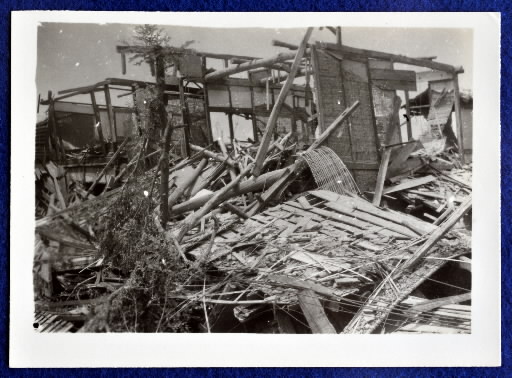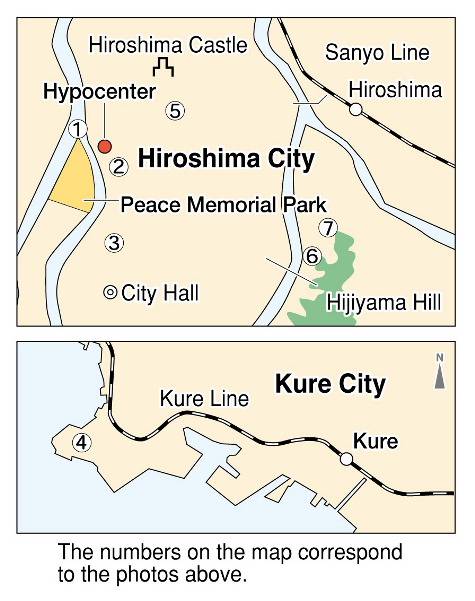- A-bomb Images
- Record of Hiroshima: In the footsteps of the Navy A-bomb survey team
Record of Hiroshima: In the footsteps of the Navy A-bomb survey team
Images of burned-out city on August 8
by Masami Nishimoto, Senior Staff Writer
The existence of rare photographs of Hiroshima taken two days after the atomic bombing of the city has been revealed. The photos were among materials preserved by Tetsuzo Kitagawa (1907-1983) along with other previously unknown materials compiled by an Imperial Japanese Navy survey team. When going over these materials, facts regarding the activities of the Navy survey team emerge. This information does not appear in the historical records of the atomic bombing held by the City of Hiroshima or Hiroshima Prefecture. Mr. Kitagawa was a physicist and chemist involved in the development of safety engineering after the war, including the invention of gas detector tubes.
"Truly pitiable"
This invention led to the founding of his company, Komyo Rikagaku Kogyo, which is based in Kawasaki in Kanagawa Prefecture. The company was eventually taken over by Mr. Kitagawa's son Fujio, 64, and it was he who discovered his father's record of his employment with the Navy Ministry. This record provided the key to learning more about the activities of the Navy's atomic bomb survey team. Mr. Kitagawa made brief daily entries in the log that he began keeping after he was commissioned as an officer in 1942. In 1945 he was a commander assigned to the Navy's Technical Research Department in Tokyo.
"My father didn't talk much about the atomic bombing," Fujio said. But in 1979, a few years before his death, Mr. Kitagawa submitted a brief essay to a journal published by the Japan Safety Appliances Association in which he recalled his involvement in the survey of Hiroshima. When the photographs and reports Fujio donated to the Yamato Museum in Kure were checked against a letter Mr. Kitagawa sent four days after the end of the war to his wife, who had evacuated to her hometown in Shiga Prefecture, the particulars surrounding the survey team became clear.
On August 7 Mr. Kitagawa took a phone call from the Navy Ministry saying that a "special bomb" had been dropped on Hiroshima the previous day. A meeting was called for 11 a.m. at naval headquarters. Under secret orders from Mitsumasa Yonai, Minister of the Navy, Mr. Kitagawa and the rest of the 10-member survey team under the leadership of Capt. Homon Yasui of the Navy Technical Department took off from Haneda Airport in a special plane at 4 p.m. and arrived at the air station in Iwakuni, Yamaguchi Prefecture at 7:30 p.m.
The group left Iwakuni at 5:30 the following morning and went to Hiroshima. There they joined up with a 13-member survey team from the Kure Naval Station led by Capt. Matao Mitsui, which had arrived in Hiroshima the day before and had begun taking photographs. The two teams met up in front of the ruins of Hiroshima Castle.
Based on the angles of buildings and trees that had collapsed as a result of the blast and the extent of damage to air raid shelters by the heat rays, both survey teams soon concluded that the bomb had exploded 300 meters south of Gokoku Shrine at an estimated altitude of 550 meters. (Subsequent research determined that the hypocenter was the Shima Hospital in what is now Ote-machi and that the bomb had exploded at an altitude of 600 meters.)
In the afternoon, the team went to the village of Kameyama (now Kabe-cho, Asa Kita Ward) to investigate the parachute that had fallen there. The local residents had evacuated the area, fearing that the cylindrical devices attached to the parachute were time bombs. Two of the devices were retrieved, and it was later determined that they were sensors that had been dropped to measure the power of the explosion. (A total of three of the devices were dropped.) A meeting with personnel at the Kure Submarine Base began at 8 p.m. and concluded at midnight.
After receiving news of the Soviet invasion of Manchuria on August 9, Mr. Yasui and his team went back to Tokyo. Mr. Kitagawa was the sole member of the Navy survey team to remain behind in Hiroshima in order to attend a meeting of a Joint Army-Navy Study Group on August 10.
The meeting was held at the Army Weapons Supply Depot (now the site of the Kasumi campus of Hiroshima University in Minami Ward), which was being used as a temporary aid station. Yoshio Nishina of the Institute of Physical and Chemical Research and Bunsaku Arakawa, a professor at Kyoto University, attended the meeting at which the members concluded that the bomb was an atomic bomb. The draft of a report to be submitted to the Imperial General Headquarters was also prepared. After collecting samples in the city for research, Mr. Kitagawa left Hiroshima on a night train.
In his log, which was solely intended as a record of his service as a naval officer, Mr. Kitagawa wrote nothing about the situation in Hiroshima other than an entry for August 8 which said, "Surveyed damage: Horrendous." But in a letter to his wife dated August 19 he described the devastation he had seen and his feelings about it.
"Hiroshima was devastated by one atomic bomb, and an area of 4 kilometers in diameter was completely destroyed by fire. (omission) The removal of the dead bodies hasn't been finished yet, so it is truly pitiable." He also wrote, "The basics of science must permeate every aspect of daily life as part of the nation's culture" in order "to build the real Japan."
While a graduate student at Kyoto University, Mr. Kitagawa studied atomic fission but noted that he could not find reference materials in Japanese. He also worked on the Navy's atomic bomb development plan along with Mr. Arakatsu and others.
In the brief essay he wrote in his later years, Mr. Kitagawa closed by saying, "The atomic bombing survey was probably the reason I have devoted my life to safety engineering. (omission) As one who took part in the survey, I would like to call on the people of all the nations that possess nuclear arms to ensure that such a tragedy will never be repeated." According to his son Fujio, Mr. Kitagawa's records of the survey, including the photographs, had all been stored in a bag. Although he was exposed to radiation upon entering Hiroshima just after the bombing, Mr. Kitagawa never applied for official designation as an atomic bomb survivor.
Memo
Fifteen prints (6.2 cm by 8.5 cm) of photographs taken on August 8, 1945, and preserved by Tetsuzo Kitagawa were donated to the Yamato Museum by his son Fujio. There was also a print (15 cm by 10 cm) of a photograph of the mushroom cloud that was taken on August 6 at the Kure Navy Arsenal. The locations of the photos were identified with the assistance of the staff of Peace Memorial Museum, curators at Hiroshima Castle, and others. The photographs of the same locations today were shot by Yasushi Muroi of the Chugoku Shimbun.
(Originally published on August 2, 2010)

